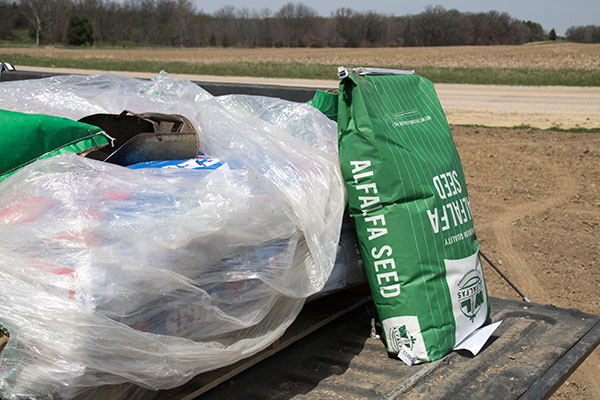Musings on the 2017 seed order |
| By Mike Rankin, Managing Editor |
|
|
 We’ve again reached that time of year when a visit from the local co-op agronomist usually has nothing to do with checking the growing crop. Rather, he or she comes calling bearing gifts of new seed catalogs and promotional fliers touting the latest and greatest for next year’s crop. Figuring the annual seed order for spring or fall plantings is usually a three-step process. Step 1 entails a determination of crop rotation to calculate the amount of forage acres being seeded. This is often the easiest of the three steps. Step 2 is deciding what varieties to purchase. I’ve previously written on this process here and here. It’s the third and final step — determining the amount of seed to purchase — that is worthy of further discussion. More to the point, what is your seeding rate going to be? It’s been my experience that many forage producers don’t know their actual seeding rate in terms of the number of viable seeds being dropped from the drill. The concept of seeding rate seems simple enough on the surface, but it actually is not when it comes to alfalfa and some grass seeds. Seed coatings have changed the game. Seeding rate may now mean pounds of product (seed plus everything that comes with it, including the coating), pounds of actual seed and whatever other small amount of nonseed components that might come in the bag (if there is no coating), or it may mean pounds of pure live seed (PLS), as it usually does in most university seeding rate research. Let’s begin with the concept of pure live seed, which rips away everything but viable and hard seed in the case of legumes. It’s defined as the germination percent times the purity percent divided by 100. If an alfalfa seed tag indicates 95 percent germination and 88 percent pure seed, the PLS is about 84 percent (95 times 88 divided by 100). Hence, to seed 15 pounds per acre of PLS, about 18 pounds of product per acre needs to be planted (15 divided by 0.84). For many years, the difference between pounds of product and pounds of PLS wasn’t significant. That’s changed with the introduction of seed coatings. Using our previous example, a bag of seed that is 60 percent PLS (not uncommon for many high volume seed coatings) needs to be planted at 25 pounds of product per acre to achieve a rate of 15 pounds per acre of PLS. That’s a big difference. Seed coatings are usually clay and/or polymer based and may contain Rhizobium bacteria, fungicide(s), and perhaps a growth regulator. They are often marketed as providing improved germination and growth, resulting in the need for less PLS to obtain the desired stand. The research literature is somewhat mixed on this point. Though it seems counterintuitive, coated seed tends to flow out of the drill faster than uncoated seed, making drill calibration important to get the desired number of seeds planted per acre. Seed marketers differ in the amount and type of seed coating applied. Though the type of seed coating is not a good variety selection criteria, knowing the amount of PLS seeded per acre is important to determine how much seed is too little or too much. At the farm level, perhaps the focus should be turned to the number of seedlings or plants established at a given point in time. After all, we don’t harvest seeding rates. For alfalfa, every 1 pound of pure seed planted per acre equates to dropping about five seeds per square foot. Lots of factors contribute to final stand density. These include: drill performance, seed placement, seedbed conditions, weather following seeding, and issues related to actual seeding rate. Your optimum seeding rate may differ from your neighbor, who has a different drill, seeding method, or soil. If stand counts are lower than desired, then try to determine the cause. It may be seeding rate; it may be something else. Realize that if you have always seeded 16 pounds per acre of noncoated seed product and now seed 16 pounds of a high-volume coated seed, your actual rate is likely somewhere below 10 pounds of PLS per acre. That might be good enough for a full, productive stand; on the other hand, it might not be. During this “get your seed order in now” time period, knowing what kind of seed product you’re buying, which includes the percent coating, is key to determining how much seed to order. |
